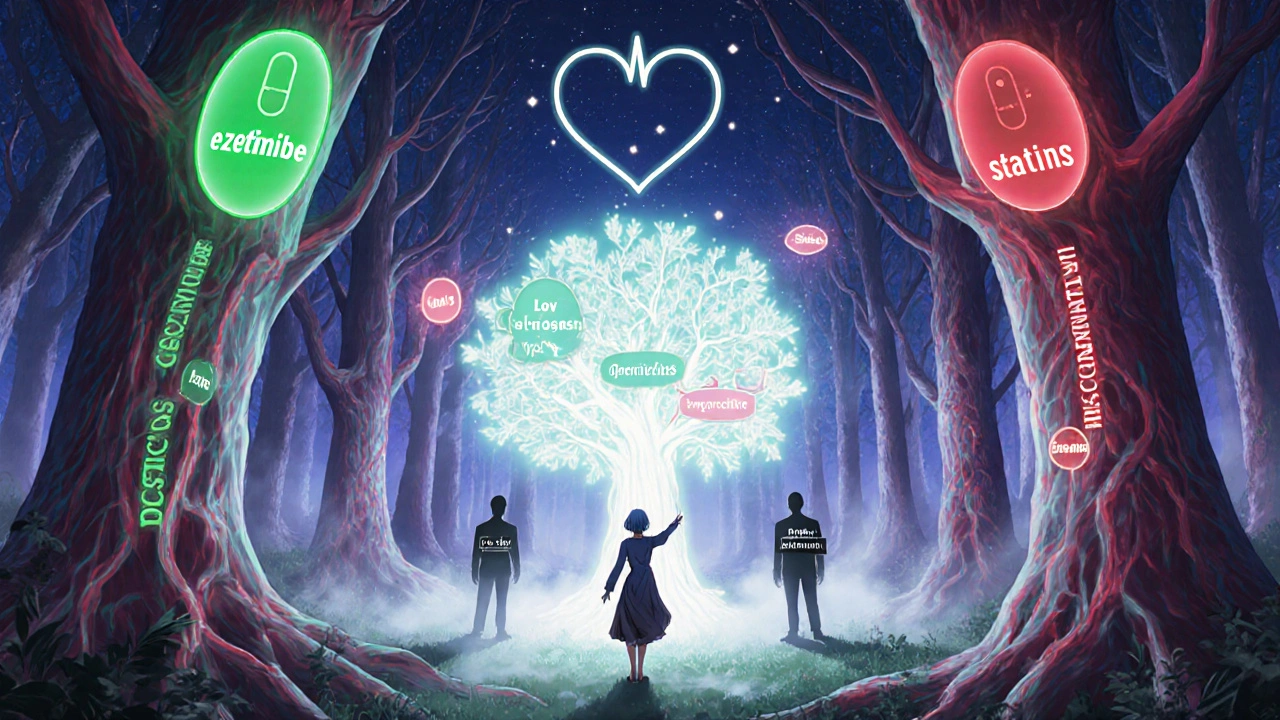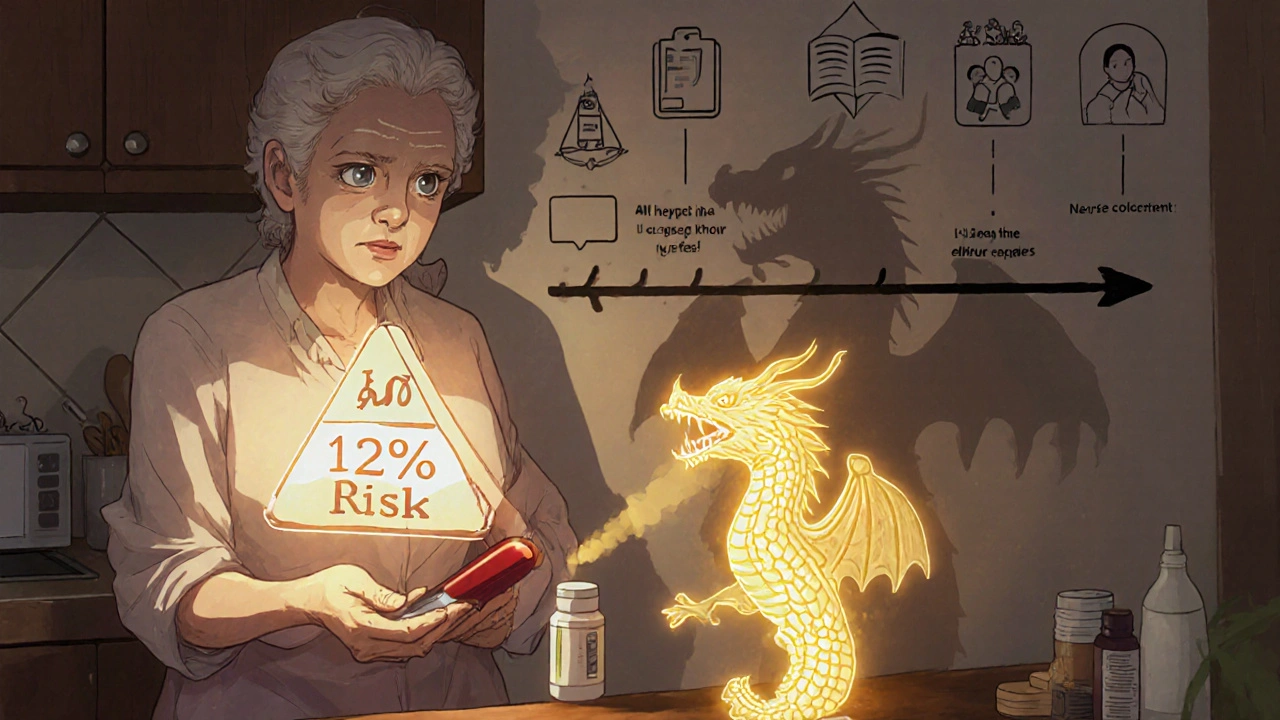Statin Side Effect Risk Calculator
This calculator uses data from clinical studies showing women experience higher rates of statin side effects. Your score reflects:
- Age (risk increases with age)
- Medication interactions (especially calcium channel blockers)
- Existing conditions (diabetes risk)
- Symptoms reported (muscle pain, fatigue)
Women take statins just like men-to lower cholesterol and prevent heart attacks and strokes. But the way their bodies react to these drugs is different. And that difference isn’t small. It’s life-changing. While statins cut heart disease risk equally in both sexes, women are far more likely to stop taking them because of side effects. Many don’t even get prescribed them in the first place, even when they should. This isn’t about being overly sensitive. It’s biology.
Why Women Get More Muscle Pain
Muscle aches, cramps, weakness-these are the top reasons women quit statins. The USAGE survey, which tracked over 5,000 patients, found that 31% of women reported new or worsening muscle symptoms compared to just 26% of men. That difference might seem small, but it adds up fast. Nearly 29% of women switched or stopped statins because of muscle pain. For men, it was 22%. And for women over 65, the risk is even higher-up to twice as likely to develop statin-induced myopathy than men their age. Why? It’s not just about being more aware of discomfort. Women have lower kidney function after adjusting for body size-about 15-20% lower glomerular filtration rate. That means statins stay in the body longer. They also tend to have more body fat and less muscle mass. Statins dissolve in fat, so they linger longer in women’s systems, increasing exposure. Add in common medications like calcium channel blockers or blood thinners, and the risk spikes even more. A 2021 study of Medicare patients found women over 75 taking statins had over twice the hospitalization rate from drug interactions compared to men.The Hidden Risk: Higher Chance of Developing Diabetes
Statins slightly raise the risk of type 2 diabetes. The FDA added this warning in 2012 after data from the JUPITER trial showed rosuvastatin increased diabetes risk by 27% over two years. A 2015 meta-analysis of 95,700 people confirmed a 9% overall increase after four years. But here’s what many don’t realize: this risk is especially notable in post-menopausal women. A 2013 study in the Journal of the American College of Cardiology found that any statin, at any dose, raised diabetes risk in women after three years of use. It didn’t matter if it was atorvastatin, simvastatin, or rosuvastatin. The effect was consistent. Some analyses suggest women face a 12% increased risk compared to 8% in men. That’s not a reason to avoid statins-it’s a reason to monitor. If you’re a woman on statins, get your fasting blood sugar checked every 3 to 6 months, especially if you’re over 50, overweight, or have a family history of diabetes.Communication Gaps That Cost Lives
It’s not just about biology. It’s about how doctors talk to women. A 2019 study of over 5,600 patients found that 42% of women said their doctor never explained how high cholesterol leads to heart disease. For men, that number was 31%. When women report muscle pain, they’re more likely to be told it’s “just aging” or “in their head.” But research shows their symptoms are real-and more common. Women are also 2.3 times more likely to try three or more different statins before finding one they can tolerate. Yet, when statins don’t work, they’re 37% less likely to be offered alternatives like ezetimibe or PCSK9 inhibitors. These drugs lower LDL without the same muscle side effects. But many providers still default to trying another statin instead of switching strategies. That’s not just inefficient-it’s dangerous. Delaying effective treatment increases heart attack risk.
Adherence Problems: Why Women Stop Taking Statins
At 12 months, only 63% of women were still taking their statin. For men, it was 77%. That 14-percentage-point gap isn’t about forgetfulness. It’s about cost, communication, and confidence. Nearly 30% of women cited cost as a reason for skipping doses-compared to 19% of men. Women often pay for family medications first. They delay refills. They skip doses to make the prescription last. And when side effects hit, they don’t always feel heard. A 2020 study in the European Heart Journal tracked 127,800 statin users. The data was clear: women with strong provider communication and clear explanations about risk versus benefit were far more likely to stick with treatment. That’s why tools like the “Statin Choice” decision aid-validated in a 2021 study with 1,200 women-cut discontinuation by 40%. It’s not magic. It’s clarity.Special Cases: Pregnancy, Menopause, and Aging
If you’re a woman of childbearing age, statins are off-limits. The FDA classifies them as Pregnancy Category X-meaning they can cause birth defects. Yet, a 2022 analysis found that 15% of prescriptions to women aged 18-45 had no documented discussion about contraception. That’s unacceptable. Every woman prescribed a statin in this age group should have a clear plan for preventing pregnancy. During menopause, estrogen drops. That speeds up artery hardening. But it also makes muscle side effects worse. The Women’s Health Initiative found 41% of post-menopausal women reported muscle pain versus 33% of pre-menopausal women. So even though statins become more necessary after menopause, they become harder to tolerate. For older women, especially over 75, the risks multiply. Polypharmacy is common. Many take statins with blood pressure meds, blood thinners, or painkillers. These combinations can spike toxicity. Simvastatin, for example, becomes 300% more dangerous when taken with certain calcium channel blockers. Doctors need to check every medication a woman is on-not just the statin.
What Works: Better Strategies for Women
The good news? We know how to fix this. Starting with a lower dose makes a huge difference. The Dutch STATINWISE trial showed that beginning with atorvastatin 10mg instead of 20mg improved adherence by 32% in women over 12 months. No need to start strong. Start low, go slow. Genetic testing is now an option. A 2023 study found that 23% of women carry a variant in the SLCO1B1 gene that increases muscle damage risk from statins. Men carry it too-but less often (18%). Testing for this before prescribing can prevent side effects before they start. It’s not routine yet, but it’s becoming more available. Provider training matters. The National Lipid Association’s 2023 “Women and Statins” curriculum improved appropriate prescribing by 27% in clinics that adopted it. Doctors who understand these differences don’t just prescribe-they partner.What You Should Do
If you’re a woman prescribed a statin:- Ask for the lowest effective dose-start with half the usual starting dose if you’re over 65 or under 130 lbs.
- Get your blood sugar checked every 3-6 months.
- Keep a symptom journal: note muscle pain, fatigue, or unusual weakness.
- Ask: “Is there an alternative if this doesn’t work?”
- Bring a list of all your medications to every appointment.
- If your doctor dismisses your symptoms, get a second opinion.
- Don’t assume statins aren’t for you because of side effects you heard about.
- Ask about your 10-year heart risk using the Pooled Cohort Equations.
- Request genetic testing if you’ve had muscle pain with other medications.
- Explore non-statin options like ezetimibe, bempedoic acid, or PCSK9 inhibitors if statins aren’t tolerated.
Bottom Line
Statins save lives. For women, they save just as many. But they come with different risks. Ignoring those differences doesn’t protect women-it harms them. The solution isn’t to avoid statins. It’s to use them smarter. Lower doses. Better monitoring. Open conversations. Genetic insight. And most of all-listening when women say they’re feeling unwell.Heart disease is the number one killer of women. Statins are one of the most effective tools we have. But only if we treat women as more than just small men.
Do statins cause more side effects in women than men?
Yes. Women are more likely to experience muscle pain, weakness, and fatigue from statins. Studies show 31% of women report muscle symptoms compared to 26% of men. They’re also more likely to stop taking statins because of side effects-nearly 29% versus 22% of men. This is due to biological differences like lower kidney function, higher body fat, and greater risk of drug interactions.
Can statins cause diabetes in women?
Yes. Statins slightly increase the risk of type 2 diabetes. For women, especially after menopause, the risk is around 12% over several years, compared to about 8% in men. This happens regardless of the statin type or dose. It’s not a reason to avoid statins, but it is a reason to monitor blood sugar every 3-6 months if you’re on long-term therapy.
Are statins safe for women over 65?
Statins can be safe for women over 65, but the risk of side effects is higher. Older women have reduced kidney function, more body fat, and often take multiple medications that interact with statins. Starting with a low dose-like atorvastatin 10mg-is recommended. Regular monitoring for muscle pain and drug interactions is essential. Women over 75 have over twice the hospitalization risk from statin-related complications compared to men their age.
Should women avoid statins during menopause?
No. Menopause increases heart disease risk due to falling estrogen levels, making statins even more important. But muscle side effects become more common during this time-41% of post-menopausal women report them versus 33% of pre-menopausal women. The solution isn’t to avoid statins, but to start low, go slow, and monitor closely. Talk to your doctor about alternatives if side effects occur.
What should I do if I have muscle pain on statins?
Don’t stop without talking to your doctor. Muscle pain on statins is real and common in women. Ask for a blood test to check CK levels (creatine kinase), which can show muscle damage. Your doctor may lower your dose, switch you to a different statin like pravastatin or fluvastatin (which have lower muscle risk), or try a non-statin option like ezetimibe. Genetic testing for SLCO1B1 variants can also help guide safer choices.
Are there alternatives to statins for women?
Yes. If statins aren’t tolerated, alternatives include ezetimibe (lowers cholesterol absorption), bempedoic acid (newer oral drug with lower muscle risk), and PCSK9 inhibitors (injectables like evolocumab or alirocumab). These are effective at lowering LDL and have fewer muscle-related side effects. Yet, women are 37% less likely to be offered these options. Ask your doctor if one is right for you.
Is genetic testing recommended before taking statins?
It’s not standard yet, but it’s becoming more useful. About 23% of women carry a gene variant called SLCO1B1 that increases the risk of muscle damage from statins. Testing for this can help choose a safer statin or avoid high-dose therapy altogether. It’s especially helpful for women with a history of muscle pain from medications or those planning long-term statin use.
Can I take statins if I’m planning to get pregnant?
No. All statins are classified as Pregnancy Category X-they can cause serious birth defects. If you’re of childbearing age and prescribed a statin, you must use reliable contraception. Doctors should discuss this before prescribing. If you’re planning pregnancy, talk to your doctor about stopping statins and managing cholesterol through diet, exercise, or safer alternatives like bile acid sequestrants.






Rachael Gallagher
23 November, 2025 . 19:03 PM
Statins are just another way the medical industrial complex exploits women. They tell us we’re ‘at risk’ so we’ll take pills while they profit. My mom died of a heart attack after being on statins for 5 years. They never asked if she felt weak. They just kept prescribing.
steven patiño palacio
24 November, 2025 . 17:01 PM
This is one of the most well-researched and balanced pieces I’ve read on statins in women. The data on muscle pain, diabetes risk, and prescribing disparities is clear. Doctors need to stop treating women as ‘small men’ and start listening. Lower doses, better communication, and alternatives like ezetimibe should be standard.
stephanie Hill
26 November, 2025 . 09:35 AM
Did you know the FDA quietly approved statins after a 3-day review? Big Pharma owns the trials. The ‘diabetes risk’? That’s just the tip of the iceberg. My cousin’s cholesterol dropped but her liver enzymes went through the roof. They called it ‘coincidence.’ Coincidence my ass. They don’t want you to know the truth.
Akash Chopda
27 November, 2025 . 09:36 AM
Statins are poison. The body makes cholesterol. Why kill it? The heart is not a pipe. They want you dependent. Watch the money. Pharma owns the doctors. No testing. No truth. Just pills. I stopped mine. I feel better. No more muscle pain. No more sugar spikes. I am free.
Nikki C
28 November, 2025 . 22:02 PM
It’s wild how biology gets ignored until it’s inconvenient. Women aren’t just men with boobs. Our livers process drugs differently. Our fat stores hold meds longer. Our kidneys aren’t the same. Yet we get the same dosing charts as 200-pound construction workers. It’s not just sexism. It’s lazy science.
I started on 10mg atorvastatin after my doctor actually listened. No pain. No sugar spike. Just steady numbers. The difference between being heard and being dismissed is everything.
Alex Dubrovin
30 November, 2025 . 09:10 AM
My grandma took statins for 12 years. Never complained. Then one day she couldn’t lift her coffee cup. They said it was ‘just old age.’ She died 6 months later from a stroke. I wish someone had told her about ezetimibe. Or that she could’ve tried half a pill. We need better options. Not just more pills.
Jacob McConaghy
1 December, 2025 . 10:33 AM
Let’s not pretend this is just about biology. It’s about who gets listened to. Women report pain more often? Good. That means we’re paying attention. But when doctors say ‘it’s just aging’ or ‘you’re overreacting,’ that’s not medical advice. That’s dismissal. The solution isn’t to avoid statins-it’s to fix how we prescribe them. Start low. Monitor. Respect the feedback.
And if you’re a woman reading this? Bring your meds list. Ask for CK levels. Say ‘I want to try something else’-and mean it.
Natashia Luu
3 December, 2025 . 05:12 AM
As a cardiologist with 28 years of experience, I must emphasize: the data presented here is not only accurate-it is critically underutilized in clinical practice. The 14-percentage-point adherence gap between genders is not a statistical anomaly; it is a systemic failure of patient-centered care. Furthermore, the failure to routinely screen for SLCO1B1 variants constitutes a breach of the standard of care in high-risk populations. I urge all practitioners to adopt the National Lipid Association’s updated guidelines immediately.
akhilesh jha
3 December, 2025 . 11:38 AM
Interesting. I didn’t know women metabolize statins differently. My sister took simvastatin and said her legs felt like lead. Doctor said it was ‘stress.’ She stopped. Then got a heart attack at 58. I wonder… if they tested her gene first, would it have been different? Maybe. But no one ever asked. Just wrote the script.
Jeff Hicken
4 December, 2025 . 00:17 AM
Statins are a scam. I took them for 3 months. Got rhabdo. Hospital. $12k bill. They never warned me. My doc just said ‘it’s rare.’ RARE? My leg muscle fell off. Now I eat garlic and walk 10k steps. My cholesterol is fine. They just want you hooked. And women? They’re the easiest to screw.
Vineeta Puri
4 December, 2025 . 03:12 AM
Thank you for this comprehensive and compassionate overview. As a primary care provider in rural India, I see this daily-women with high LDL, dismissed as ‘not sick enough,’ or prescribed statins without counseling on alternatives. The cultural stigma around discussing symptoms, especially muscle pain, is profound. We need more tools like the Statin Choice aid, translated and adapted for low-literacy settings. Empathy is not optional-it is clinical.
Victoria Stanley
4 December, 2025 . 05:31 AM
I’m a nurse and I’ve seen this over and over. Women come in with muscle pain, tired all the time, and the doctor says ‘it’s probably menopause.’ But menopause doesn’t make your calves feel like concrete. I started keeping a list of low-dose statin protocols and non-statin options in my clinic. Now 7 out of 10 women stay on treatment. It’s not magic. It’s just respect.
Andy Louis-Charles
5 December, 2025 . 10:39 AM
Just got my SLCO1B1 test back-positive. 😬 My doc said ‘cool, we’ll switch you to pravastatin.’ No muscle pain since. Seriously, if you’ve had side effects before, get tested. It’s like $100 at 23andMe. Way cheaper than a hospital trip. 🙌
Douglas cardoza
5 December, 2025 . 12:59 PM
My wife’s on a statin. She hates it. I told her to quit. She didn’t. She’s alive. That’s all that matters. I don’t care about the numbers. I care that she’s here. So yeah, maybe she’s got higher risk. But she’s not dead. And that’s the win.
Adam Hainsfurther
7 December, 2025 . 08:55 AM
One thing no one talks about: the cost. My mom skipped doses because she had to choose between her statin and her insulin. Women are the financial glue in families. We pay for everyone else’s meds first. No one tracks that. But it’s why adherence is so low. Fix the cost, fix the problem.